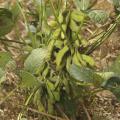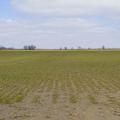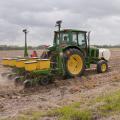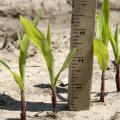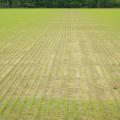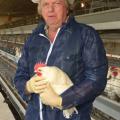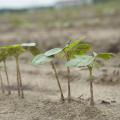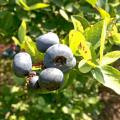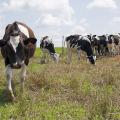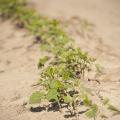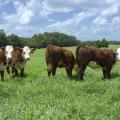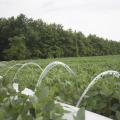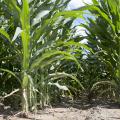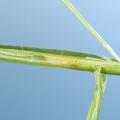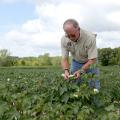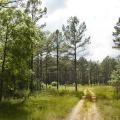Crop Report from 2015
STARKVILLE, Miss. -- Current crop prices do not clearly favor any one specific commodity, leaving growers to rely on budgets, risk management and crop rotations to guide their 2015 planting decisions.
Mississippi’s grain sorghum fields experienced a new insect pest in 2014 that could have caused significant yield losses to a large percentage of the crop.
Angus Catchot, an entomologist with the Mississippi State University Extension Service, said Extension specialists and agents acted quickly to alert growers of the new threat, heading off almost certain yield losses.
STARKVILLE, Miss. -- Mississippi wheat fields are making up for lost time after an extended cold, wet winter.
Agronomists with the Mississippi State University Extension Service said warm weather conditions are promoting growth of wheat planted last fall in the state. Most of it should be heading soon, if not already.
Don Respess, MSU Extension agent in Coahoma County, said the frequent late-winter rains made it difficult for growers to apply herbicides and fertilizer in a timely manner.
STARKVILLE, Miss. -- Seeing planters in the field is an expected part of spring in rural areas, but a lot of effort goes into making sure they run at the right time.
Planting season in Mississippi begins with corn in late February to early March and often runs into July as the last of the soybeans are planted after wheat harvest. The long planting window allows producers the opportunity to get a crop in the ground even when the weather is not ideal at typical peak planting times.
STARKVILLE, Miss. -- Almost three-fourths of the state’s corn crop has been planted, but many areas -- especially farms outside the Delta -- still have been too wet to plant.
“Rainfall has definitely delayed corn planting this spring and been our major production limitation,” said Erick Larson, grain crops agronomist with the Mississippi State University Extension Service. “We’ve got areas of the state where they were able to plant most of their intentions, and other areas where they haven’t even gotten their machines out of the shed yet.”
STARKVILLE, Miss. -- On paper, Mississippi’s rice crop is right on schedule, with half the crop planted by late April, but the reality is that recent rains have left planting at a near standstill.
In the Crop Progress and Condition Report, the U.S. Department of Agriculture estimated 49 percent of the state’s rice was planted and 30 percent emerged by April 26.
STARKVILLE, Miss. -- Grain sorghum acreage seemed likely to decrease dramatically in Mississippi in 2015 when sugarcane aphids damaged the state’s 2014 crop, but excellent prices kept acreage strong.
Erick Larson, grain crops agronomist with the Mississippi State University Extension Service, said Mississippi growers are expecting to plant about 90,000 acres of grain sorghum, or milo, this year. This is slightly lower than the number of acres planted in 2014.
STARKVILLE, Miss. -- Mississippi poultry farms remained free of avian influenza as of May 15, and growers are intensifying existing biosecurity measures to keep flocks safe.
Mark Leggett, president of the Mississippi Poultry Association, said growers and companies are working together on biosecurity.
“Whenever possible, integrators and growers are limiting visits to farms and company facilities to reduce traffic onto their property,” Leggett said. “We are all highly motivated to prevent outbreaks in Mississippi.”
STARKVILLE, Miss. -- Mississippi cotton will need a warm, dry fall to counter the mostly wet spring and thrive in 2015.
Darrin Dodds, Mississippi State University Extension Service cotton specialist and research professor in the MSU Department of Plant and Soil Sciences, said heavy springtime rains caused planting delays for the third straight year. Generally, a week-long dry spell in mid-May has been sandwiched between extended periods of consistent rainfall. Dodds said producers made quick and substantial progress planting during that interim.
POPLARVILLE, Miss. -- Frequent rains have complicated harvests and triggered some disease issues, but Mississippians’ love for blueberries will not be dampened.
Luis Monterde, a blueberry grower near Purvis, said it takes a lot of patience to grow blueberries.
DECATUR, Miss. -- Max Anderson has set an auction date. Soon, he will sell all of his 150-cow dairy herd.
Anderson will then mark the end of 38 years in the dairy business after taking over his family’s Newton County farm. After a widespread dairy economic crisis in 2009 that put him and many of his peers in debt, he finally bounced back after a profitable 2014.
“It would be foolish to dig that hole again,” Anderson said. “No one in the next generation wants to take over the dairy, and it seems like the time is right. There are more reasons to get out than stay in.”
LUCEDALE, Miss. -- Mississippi watermelon growers battled frequent rains to get their crops planted and ready in time for the Fourth of July and other summer celebrations.
David Nagel, horticulture specialist with the Mississippi State University Extension Service, said most of the crop is smaller and later than normal.
“If the sun doesn’t shine, the leaves don’t make sugar, plants don’t grow and we have smaller watermelons,” Nagel said. “Recent sunny days are allowing some of the crop to catch up. Melons may still be small, but they will be sweet and firm, or crisp.”
RAYMOND, Miss. -- High consumer demand and lower input costs have Mississippi catfish farmers filling their ponds to the brim.
“Consumer demand has stayed pretty high, and that has farmers stocking at high rates, even though pond acreage is down by almost 8 percent from last year,” said Jimmy Avery, Extension aquaculture professor at the Mississippi State University Delta Research and Extension Center in Stoneville. “We are optimistic that consumers are still out there and demanding a U.S. farm-raised product.”
STARKVILLE, Miss. -- Producers of Mississippi’s four major row crops have managed heavy spring rains followed by extended windows of muggy but mostly dry June conditions with mixed results.
These weather extremes have had different effects on corn, cotton, soybean and rice crops across the state, depending on the crop and the planting time.
STARKVILLE, Miss. -- Record beef cattle prices are making Mississippi producers happy to be in the business this summer.
Brian Williams, a Mississippi State University Extension Service agricultural economist, said 400- to 500-pound Mississippi calves are selling for $282.50 per hundredweight, and 700- to 800-pound steers are selling for $200 per hundredweight.
“Mississippi feeder cattle prices are higher this year than a year ago by about $20 to $30 more per hundred pounds,” Williams said.
STARKVILLE, Miss. -- Mississippi soybean farmers are projected to harvest the most acres in over 25 years despite narrow planting windows and issues getting the crop established.
Trent Irby, soybean specialist with the Mississippi State University Extension Service, said planting challenges as a result of wet spring weather hampered early plantings, but the crop has rebounded despite recent hot weather with sporadic rain relief.
STARKVILLE, Miss. -- Wet spring weather prevented Mississippi farmers from planting as many corn acres as they intended, but despite the heat, the crop is mostly looking good in fields across the state.
“We should have a good crop this year, but it won’t be a record,” said Erick Larson, Mississippi State University Extension Service corn specialist. “The planted acreage is down from what was intended because it was terribly rainy during spring planting, which delayed planting and restricted corn acreage.”
BILOXI, Miss. -- Mississippi fishermen remain intent on harvesting this year’s shrimp crop in the shallow waters of the Gulf of Mexico despite low prices and a season paused and restarted.
Dave Burrage, Mississippi State University Extension professor of marine resources at the Coastal Research and Extension Center in Biloxi, said the shrimp season first opened June 3, closed June 19 when shrimp were too small, and then reopened July 13.
“This season has been an anomaly so far,” Burrage said.
STARKVILLE, Miss. -- Mississippi forage producers are taking the good with the bad and dreading the ugly. The state’s pastures have produced ample grass, but they have also suffered from abundant weeds and stem maggots, and fall armyworms may soon cause even more problems.
Rocky Lemus, forage specialist with the Mississippi State University Extension Service, said summer rains have produced good growing conditions for pastures and hay production across the state. Mississippi has about 760,000 acres in hay production.
STARKVILLE, Miss. -- The cold, wet spring slowed cotton development by about 10 days, and now producers are battling plant bugs, bollworms and dry weather to bring their crops to harvest this year.
Darrin Dodds, cotton specialist with the Mississippi State University Extension Service, said bolls on most of the cotton across the state should begin to open by mid- to late August.
STARKVILLE, Miss. -- Mississippi’s timber industry is holding steady this year from 2014 as both the U.S. housing market and the demand for lumber continue to improve gradually.
State average stumpage prices for hardwood sawtimber declined sharply in the second fiscal quarter of 2015 from the first quarter, while pine sawtimber prices increased. Hardwood sawtimber is down compared to a year ago, while pine sawtimber is slightly higher.

